Dental Care for Cats
Dental Care for Cats
70% to 90% of all cats have some degree of dental disease. This can lead to bad breath, pain, and loose teeth. The most significant problems can occur when bacteria from the infected parts of the mouth enters the bloodstream, creating life threatening illnesses.
During your cat’s routine examination, we will examine your cat’s teeth and create an appropriate dental care plan. Educating our clients about preventive dental care is always where we start. Some cats can avoid in-hospital dental treatment if they receive good dental home care. Most cats will need a professional cleaning at some point in their lives. Unfortunately, in some cats, there is a genetic predisposition for dental disease. These cats will often require routine, professional dental cleanings.
Signs of Dental Disease
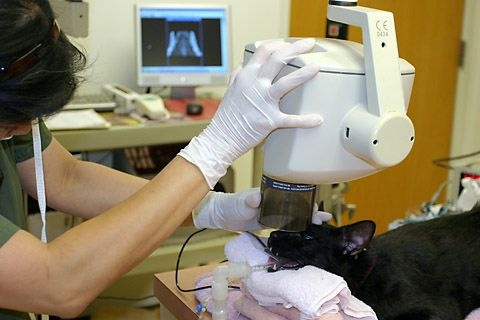
Since cats tend to hide signs of illness; it can be difficult to detect pain caused by dental disease. This is one of the reasons why an annual assessment by a veterinarian is so important. These signs of severe dental disease need to be addressed promptly:
- Bad breath
- Drooling
- Chewing on one side of the mouth
- Changes in grooming
- Pawing at mouth
- Bleeding in or around mouth
- Facial swelling
- Red or swollen gums
- Loose or missing teeth
All cats develop tartar, but some cats have more problems with tartar than others do. The longer tartar accumulates, the greater the chance it will affect the health of the teeth and gums.
The following photographs represent varying degrees of dental disease and the treatment required to resolve the problems. Obviously, cleaning the teeth early minimizes the chance of tooth extractions being necessary.
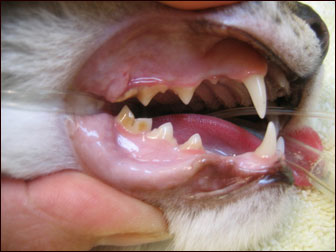
Before: mild tartar and early gingivitis
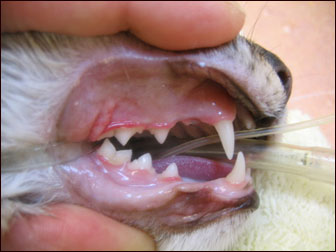
After: healthy gums and teeth
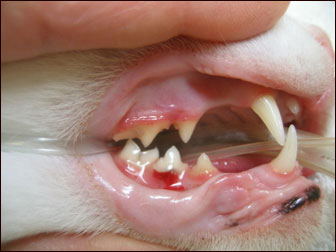
Before: mild tartar and early gingivitis
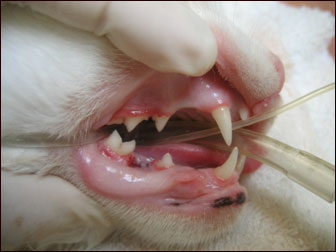
After: one tooth removed due to root involvement
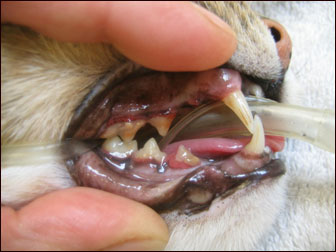
Before: severe tartar and advanced periodontitis
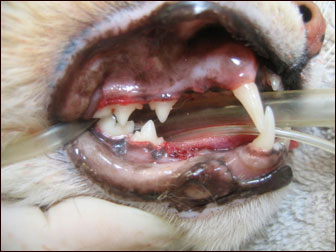
After: only one tooth removed and remaining teeth appear healthy
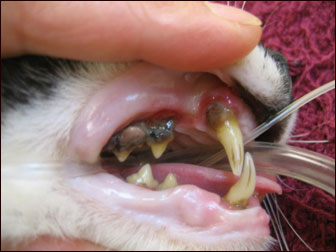
Before: severe tartar and advanced periodontitis
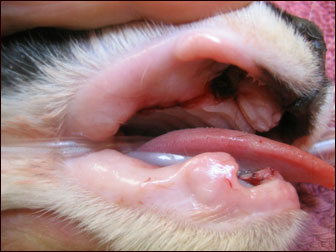
After: removal of all teeth required
Dental Home Care
Cleaning your cat’s teeth is undoubtedly beneficial to his/her health. Since cats need to be sedated to tolerate the instruments needed in professional cleanings, it’s nice to decrease the need for them if you can. Here are some guidelines to help you get the process of brushing your cat’s teeth at home going. Fortunately, it is almost always possible to get cats to adjust to having their teeth cared for, if you approach the project gradually and patiently.
Week One: At about the same time every day (ideally), put the cat in a position that is easy for you to handle. Pet the cat and give him/her a morsel of their favorite food and give praise. Then put them back on the floor.
Week Two: Do the same thing as week one, but this time also rub his/her face and gently lift the lips as well. Never push the cat beyond his/her comfort level—it is important NOT to get bitten.
Week Three: If all is going well, do as week two but also offer a small amount of toothpaste on the end of a finger—if we are lucky (s)he will like the flavor enough to lick it off. Next, gently rub his/her face to move the gel around. If (s)he doesn’t want to taste it, don’t push. Continue to gently handle his/her face a bit more each day, until you can lift up the lips and massage the gums by rubbing on the cheeks. Remember to praise and treat your cat!
Week Four or Five: You can continue at this level, but you may want to try introducing a toothbrush now, since you will get more benefit from that. Introducing the brush must be done gradually and gently to avoid frightening or hurting the cat.
For more information on cleaning your cats teeth check out Cornell University School of Veterinary Medicine's Brushing Your Cats Teeth videos.
The entire process should only take a few minutes each day. If you can’t do daily, then try to do at least 3 times a week. Otherwise, you’ll lose the training effect that has built the cat’s cooperation. Also, research shows that treatment must be done frequently to have a measurable benefit.
See Feline Dental Disease - Is Prevention Possible? for more information
This page was developed by the staff and doctors of Cats Exclusive Veterinary Center. No part of this page may be used by other businesses without prior written consent.



